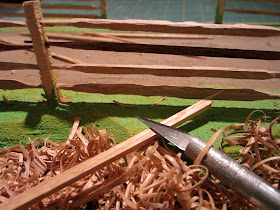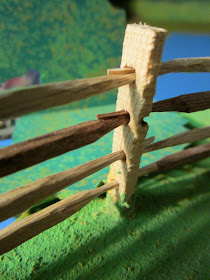The post-and-rail fence is constructed just as the actual ones are with wooden uprights, holes augered through them, and the ends of the rails resting in those holes.
Scraps of poplar, pine, and mahogany went into the construction of the fences.
This post-and-rail construction is typical of the turnpike fences of this region during the Civil War.
Here's one a portion of fence on the historic Hagerstown Pike which passes through
Antietam National Battlefield...
and here's its little brother.
The Mumma farm lane as it appears today...
and as it appeared...
on September 17, 1862.
Good fences make good neighbors, so say the grouchy neighbors anyway.
Soldier on!
Mannie








Thank you! I never would have thought of making fences this way. Just the ticket.
ReplyDeleteCheers,
Ion
I marvel at your skill sir !
ReplyDeleteVery very nice looking fences.
ReplyDeleteLooking good. As a matter of interest, what do you call too hot to work outside? We are sweating here in the west of England , but I suspect you are considerably warmer over there.
ReplyDeleteMannie that looks great. Diorama worthy not just for "toys."
ReplyDeleteTerrific work as ever Mannie. It is very inspiring. Keep it up.
ReplyDeleteCheers
Col
Just catching up on the blog - I have some home made ones and need to make more too. You can never have enough fences for the Civil War!
ReplyDeleteJust catching up on the blog - I have some home made ones and need to make more too. You can never have enough fences for the Civil War!
ReplyDeleteWhat are the dimensions of the posts and rails?
ReplyDeleteCap'n Bob,
ReplyDeleteThe posts are one and three quarters inches and the rails are five and one quarter.
Mannie